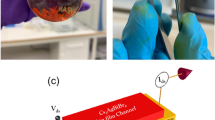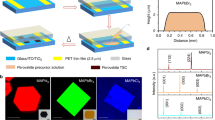Abstract
CH3NH3PbI3 perovskite films with full coverage and negligible roughness have been obtained by the two-step sequential thermal evaporation (TSSTE) process, which are further applied to fabricate thin-film transistors (TFTs). To gain the optimal electrical characteristics in our TFTs, the effect of the evaporation amount of PbI2 on the crystallization and thickness of CH3NH3PbI3 films is studied during the process of TSSTE. As a result, we demonstrate a thin-film field-effect transistors possessing a hole field-effect mobility of 3.55 cm2 V− 1 s− 1 as well as on/off ratio greater than 105 with the optimal CH3NH3PbI3 films as the channel layer. Through a further comparative analysis, MoO3 buffer layer is inserted between the perovskite channel layer and the source–drain electrode to improve the contact resistance of TFTs. As an understanding of device mechanism, a fact that insertion of MoO3 buffer layer into the Au/perovskite interface significantly reduced the contact resistance from 705 to 0.2 kΩ cm is unveiled. By inserting MoO3 buffer layer, the hole field-effect mobility of the CH3NH3PbI3 organic–inorganic hybrid TFTs can reach to 7.47 cm2 V− 1 s− 1.








Similar content being viewed by others
References
M.M. Lee, J. Teuscher, T. Miyasaka, T.N. Murakami, H.J. Snaith, Science 338, 643 (2013)
S.D. Stranks, G.E. Eperon, G. Grancini, C. Menelaou, M.J.P. Alcocer, T. Leijtens, L.M. Herz, A. Petrozza, H.J. Snaith, Science 342, 341 (2013)
M.M. Lee, J. Teuscher, T. Miyasaka, T.N. Murakami, H.J. Snaith, Efficient hybrid solar cells based on meso-superstructured organometal halide perovskites. Science 338, 643–647 (2012)
G. Xing, N. Mathews, S. Sun, S.S. Lim, Y.M. Lam, M. Grätzel,S. T.C. Mhaisalkar, Sum, Science 342, 344 (2013)
T. Matsushima et al., Solution-processed organic–inorganic perovskite field-effect transistors with high hole mobilities. Adv. Mater. 28(46), 10275–10281 (2016)
A. Yusoff et al., Ambipolar triple cation perovskite field effect transistors and inverters. Adv. Mater. 29, 8 (2017)
C.-Y. Chang et al., Formation mechanism and control of perovskite films from solution to crystalline phase studied by in situ synchrotron scattering. ACS Appl. Mater. Interfaces 8(40), 26712–26721 (2016)
C.R. Kagan, D.B. Mitzi, C.D. Dimitrakopoulos. Organic–inorganic hybrid materials as semiconducting channels in thin-film field-effect transistors. Science 286(5441), 945–947 (1999)
F. Chiarella et al., Preparation and transport properties of hybrid organic–inorganic CH3NH3SnBr3 films. Appl. Phys. A Mater. Sci. Process. 86(1), 89–93 (2007)
F. Li et al., Ambipolar solution-processed hybrid perovskite phototransistors. Nat. Commun. 6, 8238 (2015)
Y. Mei et al., Electrostatic gating of hybrid halide perovskite field-effect transistors: balanced ambipolar transport at room-temperature. MRS Commun. 5(2), 297–301 (2015)
J. Xu et al., The optimization of organic–inorganic perovskite films by annealing atmosphere for applications in transistors. Physica Status Solidi (a) 214(9), 1700170 (2017)
Y. Peng et al., The influence of PbI2 on characteristic of organic–inorganic hybrid perovskite thin films. Model. Numer. Simul. Mater. Sci. 7(04), 47 (2017)
H. Sirringhaus, Device physics of solution-processed organic field-effect transistors. Adv. Mater. 17(20), 2411–2425 (2005)
J. Zaumseil, H. Sirringhaus, Electron and ambipolar transport in organic field-effect transistors. Chem. Rev. 107(4), 1296–1323 (2007)
Y. Wu et al., Organic–inorganic hybrid CH3NH3PbI3 perovskite materials as channels in thin-film field-effect transistors. RSC Adv. 6(20), 16243–16249 (2016)
J. Meyer et al., Highly efficient simplified organic light emitting diodes. Appl. Phys. Lett. 91(11), 113506 (2007)
C.-W. Chu et al., High-performance organic thin-film transistors with metal oxide/metal bilayer electrode. Appl. Phys. Lett. 87(19), 193508 (2005)
A.G.F. Janssen et al., Highly efficient organic tandem solar cells using an improved connecting architecture. Appl. Phys. Lett. 91(7), 073519 (2007)
F.-C. Chen, L. Cheng-Hao, Construction and characteristics of tandem organic solar cells featuring small molecule-based films on polymer-based subcells. J. Phys. D Appl. Phys. 43(2), 025104 (2009)
D. Kumaki, T. Umeda, S. Tokito, Reducing the contact resistance of bottom-contact pentacene thin-film transistors by employing a MoOx carrier injection layer. Appl. Phys. Lett. 92(1), 1 (2008)
S. Cacovich, L. Ciná, F. Matteocci et al., Gold and iodine diffusion in large area perovskite solar cells under illumination. Nanoscale 9(14), 4700 (2017)
K. Domanski, J.P. Correabaena, N. Mine et al., Not all that glitters is gold: metal-migration-induced degradation in perovskite solar cells. ACS Nano, 2016, 10(6)
D.J. Gundlach et al., An experimental study of contact effects in organic thin film transistors. J. Appl. Phys. 100(2), 024509 (2006)
P.V. Necliudov et al., Contact resistance extraction in pentacene thin film transistors. Solid-State Electr. 47(2), 259–262 (2003)
H. Klauk et al., Contact resistance in organic thin film transistors. Solid-State Electr. 47(2), 297–301 (2003)
T. Minari, P. Darmawan, C. Liu et al., Highly enhanced charge injection in thienoacene-based organic field-effect transistors with chemically doped contact. Appl. Phys. Lett. 100(9), 59 (2012)
W. Zhang et al., Ultrasmooth organic–inorganic perovskite thin-film formation and crystallization for efficient planar heterojunction solar cells. Nat. Commun. 6, 6142 (2015)
Acknowledgements
The work reported here was supported by National Natural Science Foundation of China (Project No. 61076006), National Natural Science Foundation of China (Zhang; Project No. 61377031) and the Flat-Panel Display Special Project of China’s 863 Plan (Project No. 2008AA03A335).
Author information
Authors and Affiliations
Corresponding author
Rights and permissions
About this article
Cite this article
Tang, L., Peng, Y., Zhou, Z. et al. High-performance organic–inorganic hybrid perovskite thin-film field-effect transistors. Appl. Phys. A 124, 624 (2018). https://doi.org/10.1007/s00339-018-2049-8
Received:
Accepted:
Published:
DOI: https://doi.org/10.1007/s00339-018-2049-8




